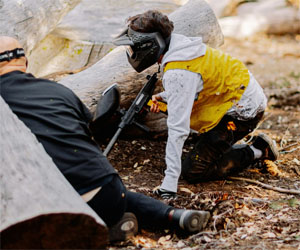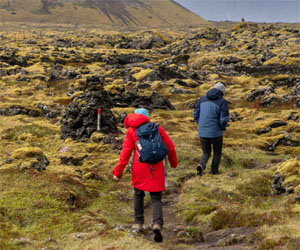



In a world where technology and the demands of daily life often keep us indoors and tethered to our screens, there's an undeniable allure to the great outdoors. Whether you're an avid adventurer or someone looking to escape the confines of urban living, the thrill of the great outdoors is a siren's call that beckons us to explore, connect, and find exhilaration in the wild.
One of the most remarkable aspects of the great outdoors is the sense of freedom it offers. It's a place where the boundaries of your everyday life dissolve, and you're free to wander where your heart desires. From the rugged mountain trails to the serene lakeshores, nature invites us to embrace the spirit of exploration and embark on journeys that lead to breathtaking vistas and hidden treasures.
The thrill of the great outdoors is deeply rooted in the elements of unpredictability and challenge. Whether you're hiking steep terrain, navigating winding rivers, or embarking on a multi-day backpacking expedition, the natural world demands adaptability and resilience. These challenges push your limits and offer a sense of accomplishment that's hard to replicate in any other setting.
Furthermore, the great outdoors is a place where you can reconnect with your most primal instincts. As you explore the wild, you'll find yourself more attuned to your surroundings—the scent of pine in the air, the call of distant birds, and the sensation of the earth beneath your feet. These sensory experiences awaken a deep connection to the environment, one that is often lost in the hustle and bustle of modern life.
The thrill of the great outdoors is also an opportunity to escape the ceaseless digital noise. With limited or no connectivity, you're free from the constant barrage of emails, social media updates, and text messages. Instead, you're left with the quietude of nature, a chance to listen to the wind rustling through the leaves and to engage in conversations that are truly face-to-face.
Another aspect of the thrill of the great outdoors is the sense of awe it inspires. Whether you're standing on the edge of a canyon, watching a waterfall cascade into a pristine pool, or gazing up at a starlit night sky, nature's grandeur is a humbling experience. The vastness and beauty of the world around us reminds us of our place within it, fostering a deep appreciation for the Earth's wonders.
The thrill of the great outdoors is an invitation to leave the confines of your comfort zone and embrace the untamed world. It's an opportunity to escape the daily grind, to explore, and to feel the exhilaration that comes from facing nature's challenges head-on. Whether you're an outdoor enthusiast or a novice, the great outdoors offers a journey of discovery, adventure, and wonder. It's a reminder that there is a world of excitement beyond the screens and buildings, waiting for those who are willing to venture into it. So, heed the call of the wild and experience the thrill of the great outdoors for yourself.
The Drive For Excellence
 Skill Development: Pickleball requires a unique set of skills that combine the finesse of table tennis, the agility of badminton, and the strategic elements of tennis. Competitive players dedicate significant time to developing these skills, including shot placement, spin control, and precision. The pursuit of mastery in these areas is a key driver of competitiveness.
Skill Development: Pickleball requires a unique set of skills that combine the finesse of table tennis, the agility of badminton, and the strategic elements of tennis. Competitive players dedicate significant time to developing these skills, including shot placement, spin control, and precision. The pursuit of mastery in these areas is a key driver of competitiveness.
Strategic Play: While pickleball is known for its social and recreational appeal, competitive players bring a new level of strategic thinking to the game. Each point is a mini-battle of wits, with players analyzing their opponents' weaknesses, anticipating shots, and creating opportunities for winning plays. Strategic innovations such as the third shot drop and stacking are embraced to gain a competitive edge.
Tournaments And Rankings: The competitive aspect of pickleball is exemplified by the numerous tournaments held worldwide, attracting players who aim to compete at the highest levels. These events include local, regional, national, and international competitions. The excitement and prestige associated with tournaments drive players to continually refine their skills and seek recognition in the form of rankings and titles.
Strategies For Success
 The Role Of Challenge Tactics In Paintball
The Role Of Challenge Tactics In Paintball
Challenge tactics in paintball involve tackling specific scenarios or obstacles that can impede your team's progress. These challenges can range from breaking through enemy lines to capturing a flag or defending a critical position. Mastering these tactics is essential for success in paintball, as they can turn the tide of the game in your favor.
Key Challenge Tactics In Paintball
Flag Capture And Defense: Many paintball games involve capturing flags or other objectives. To excel in this challenge, designate a team member or a group to capture the flag, while others provide cover and defend the area. Communication and coordination are vital to ensure the flag reaches its destination.
Obstacle Negotiation: Paintball fields are typically filled with various obstacles and structures. Knowing how to navigate these obstacles effectively, whether by using them as cover or as a vantage point, is crucial for success.
Suppressive Fire: When faced with a challenge, laying down suppressive fire can keep your opponents at bay. This tactic allows your team to move, reload, or change positions while restricting the movement of the opposing team.
Crisis Management: Sometimes, unforeseen challenges arise during a game, such as a key player being eliminated or a sudden change in the game's objective. Being able to adapt and manage such crises is an essential paintball skill.
Distraction And Feint: Employ diversion tactics to distract the enemy and lead them away from critical areas. By creating diversions, you can maneuver your team or carry out other objectives without immediate opposition.
Discovering The Diverse Homes Of Avian Wonders
 Biodiversity Hotspots: Bird habitat exploration often leads to encounters with a wide array of species, both avian and non-avian. Many birdwatchers are surprised by the diversity of life they discover in these natural areas. These hotspots of biodiversity are crucial for the survival of countless species, making them a focus of conservation efforts.
Biodiversity Hotspots: Bird habitat exploration often leads to encounters with a wide array of species, both avian and non-avian. Many birdwatchers are surprised by the diversity of life they discover in these natural areas. These hotspots of biodiversity are crucial for the survival of countless species, making them a focus of conservation efforts.
Understanding Niche Occupancy: Different bird species have evolved to occupy specific ecological niches within their habitats. Observing these niches can reveal intricate patterns of competition and cooperation among species. For example, in a wetland habitat, various bird species may have distinct feeding strategies, such as waders probing in the mud and waterfowl foraging on the surface.
Migration And Seasonal Changes: Bird habitat exploration allows us to witness the remarkable journeys of migratory birds. These avian travelers cover vast distances between their breeding and wintering grounds. Birdwatchers in these habitats can experience the excitement of witnessing the arrival of migratory flocks, marking the changing seasons.
Conservation Insights: Understanding the habitats that birds rely on is critical for conservation. Many bird species are dependent on specific habitat types, and these areas are often threatened by habitat destruction and climate change. By exploring bird habitats, we can better appreciate the urgency of conserving these vital areas and work towards their protection.
Educational Opportunities: Bird habitat exploration offers rich educational opportunities. It can be a valuable tool for teaching ecology, environmental science, and biodiversity. Schools, nature centers, and environmental organizations often organize field trips to bird habitats to engage students and the public in conservation efforts.
Where Thrill Meets Nature
 Unlike traditional road biking, mountain biking offers an escape from the hustle and bustle of city life. Riders have the opportunity to explore remote and untouched natural landscapes. These less-accessible areas are often devoid of crowds, providing the solitude and tranquility that many nature enthusiasts seek. Mountain bikers have the privilege of delving deep into the wilderness, where they can revel in the serenity of the outdoors.
Unlike traditional road biking, mountain biking offers an escape from the hustle and bustle of city life. Riders have the opportunity to explore remote and untouched natural landscapes. These less-accessible areas are often devoid of crowds, providing the solitude and tranquility that many nature enthusiasts seek. Mountain bikers have the privilege of delving deep into the wilderness, where they can revel in the serenity of the outdoors.
The diversity of environments that mountain bikers can explore is astounding. From dense, verdant forests to arid, rocky deserts, there's a terrain to suit every rider's preference. Whether one desires the lushness of the woods or the technical challenges of rocky trails, mountain biking offers a variety of settings to explore.
Mountain biking encourages an environmentally conscious approach to outdoor adventure. Riders are typically aware of the importance of preserving the natural environment and adhere to the principles of "leave no trace." This responsible ethos includes not disturbing wildlife, avoiding littering, and respecting trail rules and guidelines. This ensures that the beauty of the outdoors remains intact for generations to come.
The sense of adventure and camaraderie further enhances the experience of mountain biking in the great outdoors. Riding with friends or participating in group rides allows riders to share the thrill and magnificence of the journey. The bonds formed on the trail often lead to lasting friendships and a shared passion for outdoor exploration.
The great outdoors also opens the door to challenging terrain. Mountain biking trails often feature steep descents, rocky paths, tight switchbacks, and technical sections.
 Understanding The Basics: Mastering the art of outdoor adventure begins with understanding the fundamentals. Start by learning essential outdoor skills, such as navigation, first aid, and wilderness survival. These skills are your foundation, providing the knowledge and confidence you need to thrive in the great outdoors. Take courses or workshops, read books, and practice these skills until they become second nature.
Understanding The Basics: Mastering the art of outdoor adventure begins with understanding the fundamentals. Start by learning essential outdoor skills, such as navigation, first aid, and wilderness survival. These skills are your foundation, providing the knowledge and confidence you need to thrive in the great outdoors. Take courses or workshops, read books, and practice these skills until they become second nature.
Gear And Equipment: Choosing the right gear and equipment is crucial for any outdoor adventure. Invest in high-quality gear that suits your specific activities, whether it's hiking, camping, kayaking, or rock climbing. Proper equipment enhances your safety, comfort, and overall experience. However, keep in mind that more gear doesn't always mean a better adventure. Learn to pack efficiently and carry only what you need to minimize your environmental impact.
Leave No Trace: One of the most important aspects of mastering outdoor adventure is practicing Leave No Trace principles. Leave No Trace is an ethical framework that encourages responsible outdoor recreation. It involves leaving natural areas as you found them, minimizing human impact on the environment. This includes packing out all trash, respecting wildlife, and staying on designated trails. By following these principles, you contribute to the preservation of our wilderness areas for future generations.
Fitness And Conditioning: Outdoor adventures often demand physical and mental stamina. Regular physical conditioning is essential for mastering the art of outdoor adventure. Train your body for the specific activities you plan to undertake. Build strength, endurance, and flexibility. Additionally, mental fortitude is equally important. Prepare yourself to face challenges, adapt to unexpected situations, and stay calm under pressure.
A Journey From Novice To Pro
 Turning: Start with basic wedge turns, also known as snowplow turns. As you progress, aim to transition to parallel turns, where both skis move together smoothly.
Turning: Start with basic wedge turns, also known as snowplow turns. As you progress, aim to transition to parallel turns, where both skis move together smoothly.
Stopping: Perfecting your stopping technique is crucial for safety. Master the art of the snowplow stop before progressing to more advanced methods.
2. Progressing To Intermediate Level
Once you've established a solid foundation, it's time to advance your skills:
Carving: Carving involves using the edges of your skis to create smooth, controlled turns. Focus on edging and weight distribution to perfect your carving technique.
Terrain Variety: Experiment with different types of slopes, from groomed runs to more challenging terrain. Learning to navigate varying conditions will broaden your skiing skill set.
Speed Control: Advanced skiers have precise control over their speed. Work on your ability to increase or decrease your velocity as needed, enhancing your overall mastery of the mountain.
3. Embracing Advanced Techniques
To truly excel in skiing, consider these advanced techniques:
Moguls: Tackling mogul fields is a hallmark of a seasoned skier. Learning to absorb the bumps with your legs and make controlled turns around them takes practice and finesse.